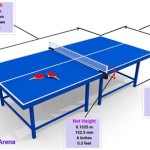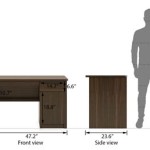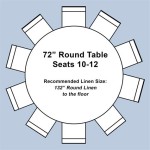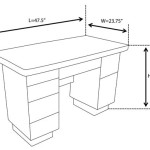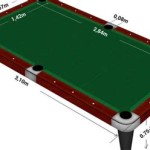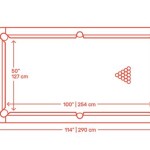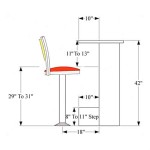Standard Height of Study Table and Chair: Optimizing Ergonomics for Enhanced Learning
The standard height of a study table and chair is a critical factor in creating an ergonomic and comfortable learning environment. Proper posture, reduced strain, and improved focus are all directly linked to the appropriateness of the furniture dimensions. Understanding the principles behind optimal height adjustments and the recommended measurements for different age groups is essential for promoting healthy study habits and preventing long-term musculoskeletal issues.
This article will delve into the significance of selecting correctly sized study furniture. It will explore the general guidelines for table and chair heights, highlighting the importance of adjustability and personal customization. Furthermore, the potential ramifications of using ill-fitting furniture and practical tips for ensuring an ergonomic setup will be discussed. Finally, we examine the impact of furniture design and material choices on overall comfort and well-being.
Why Standard Height Matters: Ergonomics and Health
Ergonomics, the science of designing workspaces to fit the human body, plays a pivotal role in determining the appropriate height of study tables and chairs. The goal is to minimize physical strain and maximize efficiency. When furniture is improperly sized, it forces the user to adopt unnatural postures, leading to discomfort and potential health problems. Poor posture can negatively impact breathing, circulation, and digestion, as well as contributing to headaches and fatigue. Chronic musculoskeletal issues, such as back pain, neck stiffness, and carpal tunnel syndrome, can develop over time as a result of prolonged use of ill-fitting furniture.
A study table that is too low forces the user to hunch forward, straining the back and neck muscles. Conversely, a table that is too high may cause the shoulders to be elevated, leading to muscle tension and discomfort in the arms and wrists. A chair that is too low can lead to slouching, which compresses the spine and restricts breathing. A chair that is too high can cause the feet to dangle, putting pressure on the back of the thighs and restricting circulation. By adhering to standard height guidelines and prioritizing ergonomic principles, these negative consequences can be avoided.
Beyond physical health, proper ergonomics also contribute to enhanced concentration and focus. Discomfort and pain can be highly distracting, making it difficult to concentrate on studying or completing tasks. When the body is comfortable and supported, the mind is free to focus on the task at hand, leading to improved productivity and academic performance. Therefore, the standard height of a study table and chair is not merely a matter of comfort but a key factor in optimizing the learning experience.
Recommended Height Guidelines for Different Age Groups
The ideal height of a study table and chair varies depending on the age and height of the user. As children grow, their furniture must be adjusted accordingly to ensure continued ergonomic support. The following are general guidelines for recommended table and chair heights, but it's crucial to remember that individual needs may vary. These estimations are based on average height ranges for each age group and should be used as a starting point for finding the most comfortable and appropriate setup for each individual.
Children (Ages 5-7): For children in this age group, a study table height of approximately 18-20 inches (45-50 cm) and a chair height of around 10-12 inches (25-30 cm) are typically recommended. These dimensions allow children to sit comfortably with their feet flat on the floor and their elbows at a 90-degree angle when resting on the table. Providing appropriate furniture at this age is crucial for developing good posture habits early on.
Children (Ages 8-11): As children grow, the recommended table height increases to approximately 22-24 inches (55-60 cm), and the chair height should be around 12-14 inches (30-35 cm). This allows for continued ergonomic support as children engage in more complex study activities. Ensure children are not straining to reach the table or slouching to compensate for a chair that is too high.
Teenagers (Ages 12-15): Teenagers typically require a study table height of approximately 26-28 inches (65-70 cm) and a chair height of around 15-17 inches (38-43 cm). This allows for comfortable studying and homework completion as academic demands increase. Adjustable furniture becomes particularly valuable during this stage of rapid growth, allowing for customized settings that adapt to the individual's needs.
Adults (Ages 16+): For adults, a standard desk height of approximately 29-30 inches (73-76 cm) is generally recommended. The chair height should be adjustable to allow for optimal legroom and a comfortable seating position. Ideally, the chair should allow the user to sit with their feet flat on the floor or on a footrest, with their knees bent at a 90-degree angle and their elbows resting comfortably on the table.
It is important to note that these are just general guidelines, and individual variations in height and body proportions should be taken into consideration. The best way to determine the appropriate height for study furniture is to have the user sit at the table and chair and assess their posture. The goal is to achieve a neutral spine position with the shoulders relaxed and the elbows bent at a comfortable angle. Adjustable furniture provides the flexibility to fine-tune the setup and ensure optimal ergonomic support.
Practical Tips for Achieving an Ergonomic Study Setup
Selecting furniture with the appropriate standard height is just the first step in creating an ergonomic study setup. Several other factors contribute to optimizing the workspace and promoting good posture. Here are some practical tips for ensuring a comfortable and supportive learning environment:
Adjustable Furniture: Invest in adjustable study tables and chairs whenever possible. Adjustable furniture allows for customization to fit individual needs and can be modified as the user grows or if multiple people will be using the same workspace. Look for chairs with adjustable seat height, back support, and armrests. Tables with adjustable legs can also be beneficial for achieving the perfect height.
Proper Posture: Maintain good posture while studying. Sit upright with your back straight and your shoulders relaxed. Avoid slouching or hunching forward. Use a lumbar support cushion if necessary to maintain the natural curve of your spine. Keep your feet flat on the floor or on a footrest. If the chair doesn't allow for comfortable foot placement, a footrest can help alleviate pressure on the back of the thighs.
Monitor Placement: If using a computer, position the monitor at arm's length and at eye level. This will prevent neck strain and encourage proper head posture. Use a monitor stand or adjustable arm to achieve the correct height and angle. Regular breaks from screen time are also essential to prevent eye strain and fatigue.
Lighting: Ensure adequate lighting in the study area. Poor lighting can lead to eye strain and headaches. Use a combination of natural and artificial light to create a bright and comfortable environment. Position a desk lamp to provide focused light on the work surface.
Regular Breaks: Take regular breaks to stretch and move around. Prolonged sitting can lead to stiffness and discomfort. Get up and walk around every 30-60 minutes to improve circulation and reduce muscle tension. Simple stretches can help to relieve stiffness in the neck, shoulders, and back.
Workspace Organization: Keep the study area organized and free from clutter. A cluttered workspace can be distracting and can contribute to stress. Keep all necessary materials within easy reach to avoid unnecessary stretching or reaching. Use drawers, shelves, and organizers to keep the workspace tidy and efficient.
By following these practical tips, users can create an ergonomic study setup that promotes comfort, reduces strain, and enhances focus. Prioritizing ergonomics is an investment in long-term health and well-being.

This Is Why Desk Height Matters For Your Posture Arteil

Children S Furniture Standard Dimensions Google Search Kids Study Table And Chairs Chair

Desk Height Calculator Office Ergonomics In A Blink

School Furniture Sizes Chair Table Height Guidelines Tables

Optimal Height Guide Woods Furniturewoods Furniture

Desk Height How High Should My Be Brother

What Is The Standard Office Chair Height Quora

Optimal Height Guide Woods Furniturewoods Furniture
Ergonomics What S The Ideal Height For A Laptop Desk Quora

Up To 70 Off On Study Room Furniture Summer Urban Ladder

